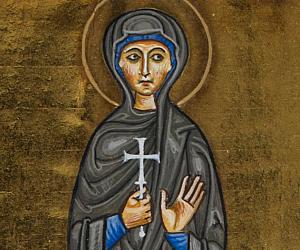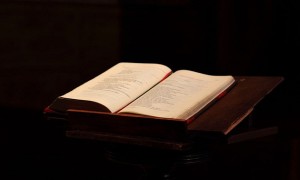The Word of God and the Church from an Orthodox Perspective-3
5 October 2017c. The word of God, the Mysteries and sacramentalism. The correct understanding of “mystery” was always the touchstone of Christian teaching and life – not only in the early Christian community, when the Church contended with an assortment of mystery cults, but also much later, when an exclusively scholastic theology developed (in both the West, and the East) a sacramentalistic view of the Christian mysteries.[xii] It is worth remembering that the crux of that theological conflict during the Reformation was a sacramentalistic view of the Holy Eucharist, which tragically ended in the complete departure of Protestant theology from the original mysteriology of the undivided Church. The dialectical antithesis between “sacramentalism” (which dominated pre-Vatican II Roman Catholic theology, but also some medieval Orthodox thinking) and “the rejection of mystery” (in some Protestant circles before the ecumenical era) resulted in the secularization of society and the transformation of the Church into a religion – either cognitive or cultic – which is even more tragic.
In the contemporary ecumenical dialogue, Orthodoxy, for two or more generations, has used the authentic Christian mysteriology as its principle weapon. It is quite characteristic that most responses by the Orthodox Churches to the WCC’s text regarding the understanding of Baptism, Eucharist, and Ministry (known as BEM) underline the necessity of a deeper elaboration of the Christian view of “mystery.” The distinguished British ecclesiologist M.E.Brikman, speaking about the Orthodox theology’s contribution to the ecumenical discussion at the General Assembly in Vancouver (1983) and afterwards, asserted that the “sacramental” view of reality is the only solution to the impasses and dilemmas of sacramentalistic theology, as well as to the theology of creation.[xiii] Given, therefore, the adherence of nearly all the Orthodox engaged in the ecumenical dialogue on the significance of Sacraments – over and above the significance even of the word of God[xiv] – we believe that a profound study of the significance and theological importance of Christian mysteriology is urgently needed.
d. Mystery and kerygma (or the word of God) in the Bible. Of course, the term “mystery,” a clearly religious terminus technicus, is derived, etymologically, from the verb “μύειν” (which means “to close the eyes and mouth,” and not from the verb “μυεῖν,” which means ‘to dedicate’).[xv] In antiquity it is recorded (primarily in the plural) in rituals with secret teachings, both religious and political, and accompanied by a host of exotic activities and customs. These mysteries may have originated in the ritualistic activities of primitive peoples, but they took much of their shape from the Greek world (Dionysiac, Eleusinian, Orphic, etc) and then combined creatively with various Eastern cults before assuming their final form during the Greco-Roman period. Because Christianity developed during the height of the mystery cults, and because of the notable resemblances between them, the history of religions school of thought formulated the theory of reciprocal dependence – and in particular the dependence of Christianity on the mystery cults.
In biblical (O.T., N.T. even Inter-testamental) literature, as well as in the early post-biblical one, the term “mystery” was always connected with cultic ritual or with the liturgical expression of the people of God (Israel in the O.T., the Church in the N.T.). In the Septuagint, it appears for the first time in the Hellenistic literature (Tobit, Judith, Wisdom, Sirach, Daniel, Maccabees), where it is frequently used pejoratively to describe the ethnic mystery religions (cf. Wisdom of Solomon 14:23: “secret mysteries…[ connected with] child sacrifices”), or to imply idolatry.[xvi] In Daniel, the term “mystery” assumes, for the first time, a very significant connotation, that of eschatology, and in that meaning it was further developed later.[xvii]
The only use of the term in the Gospels occurs in the Synoptic tradition, in the famous interpretation of the parables – “the mystery (-ies) of the Kingdom of God (of heaven)” (Mark 4:11 par.). Here, as also in the corpus paulinum,[xviii] the term is connected with the kerygma, not with ritual (as in the various mystery cults), and it was very often used in connection with the terms of revelation.[xix] Generally, in the N.T., mystery is never connected with secret teachings, nor do we encounter any admonitions against defiling the mystery, as in the mystery cults.
There is ample evidence in the letters of the Apostle Paul that, in certain circles of the EarlyChurch, the significance of the Lord’s Supper and, by extension, the profound meaning of the Eucharist, was interpreted in the light of the Hellenistic mystery cults’ rituals, and thus the mysterion was believed to transmit an irrevocable salvation. Paul attempts to correct this view on the basis of ecclesiological criteria – his teaching on spiritual gifts and the Church as “the Body of Christ.”
According to the sacramentalistic view of the mystery cults, the person acquires, via the mysteries, a power of life that is never lost. In the mystery groups and the more general syncretistic environment of Early Christianity, it was widely believed that the human beings were connected with the deity through the initiation; they could acquire eternal salvation only by participating in the deity’s death and resurrection.[xx] The Gnostics , being influenced by the mystery cults and adopting a “sacramentalistic” view, even performed baptism for the departed in an attempt to activate this indestructible power over death. The Apostle Paul refutes this magical/sacramentalistic view of baptism in his Epistle to the Romans (Rom 6:3-11). It is of course true that he interprets baptism in theological terms as participation in Christ’s death on the cross, but at the same time he insists, that this must have consequences in the moral life of the faithful. For this reason, he exhorts the baptized to “walk in newness of life” (6:4) “so that we might no longer be enslaved to sin” (6:6).[xxi]
Ephesians 3:3-12 is characteristic of the Pauline (and the New Testament in general) understanding of “mysterion.” There Paul’s mission to the Gentiles is clearly described as “the plan of the mystery hidden for ages in God who created all things through Jesus Christ; that through the Church the manifold wisdom of God might now be made known to the rulers and authorities in the heavenly places” (3:9-10). Mystery, therefore, is the hidden plan of God for the salvation of the whole world. The Church, then, by extension, is considered a “mystery”, where this mystery of salvation is accomplished. And because the Church is neither the sum of beliefs of some religious system, nor some mystery cult, but rather the collective manifestation of the Kingdom of God, the Holy Eucharist was also characterized as a “Mystery”, more precisely the Church’s Mystery par excellence. Until the 4th century AD, the term “mystery” and its derivatives were not connected in any way with that which later came to be called Sacraments.[xxii] The Gospel of John in particular had established the ecclesiological dimension of the Christian mysteries, and particularly of the Eucharist as a communion event, and not a mystery cult-inspired action of individual piety. This communion event is an expression of the Church as the people of God and as the Body of Christ mystically united with its head, Christ, and not some sacramentalistic ritual or magical rite.
The major change occurred at the beginning of the 4th century AD, after the acceptance of Christianity as a recognized – and later as the official or even “State”– religion of the Roman Empire. The Church at that time, seeking to attract as many groups as possible in its mission to the world, not only began to adopt sacramental terminology, but also described its ecclesiastical rituals as superior to those of the mystery cults. Her rituals became “mysteries”, and the “presbyters” (and “bishops”) became priests (and archpriests). In an effort to maintain a sense of holiness amidst the mass conversions to Christianity, the Church began to describe her logike latreia (rational eucharistic worship) not in authentic terms, but in mystic/sacramentalistic ones (awful, awe-inspiring, etc).[xxiii]
[To Be Continued]
[xii] By this term “sacramentalistic” I mean a somewhat magical understanding of the Christian mysteries. Prominent theologians of the East, up to and including Nicholas Cabasilas, tried in vain to redefine Christian mysteriology along Trinitarian lines – that is, by reminding us of the role of the Holy Spirit in an effort to prevent Christomonistic tendencies (cf. the cases of filioque, the epiclesis, etc. More in my, Orthodoxy at the Crossroa, p. 33 ff. and 91 ff. The result was lamentable: a split in the One Body of Christ – in the unity of the One, Holy, Catholic, and Apostolic Church – with the schism between East and West, and the subsequent split during the Reformation.
[xiii] M.E. Brikman, “Creation and Sacrament,” Exchange 19 (1990), pp. 208-216.
[xiv] Cf. Th. FitzGerald, “Faith, Sacraments, and the Unity of the Church: The Text and a Response,” Greek Orthodox Theological Review 34 (1989), pp. 151-166.
[xv] “They were called mysteries because they close their mouths and nothing is explained to anyone. And μύειν is the closing of the mouth” (Scholia to Aristophanes, 456).
[xvi] G. Bornkamm, “μυστήριον, μυέω,” Theological Dictionary of the New Testament, Vol. IV, p. 813.
[xvii] Ibid., p. 814.
[xviii] For more, cf. W. Bauer’s Lexicon of the New Testament.
[xix] For more, cf. G. Bornkamm, “μυστήριον, μυέω,” p. 821 ff.
[xx] Cf. S. Agouridis’s commentary on 1 Corinthians, Chapter 10 (St. Paul’s 1st Epistle to the Corinthians, 1982, p. 161 ff. in Greek), which he aptly titles: “The mysteries are not a guarantee for the future,” and “Christianity is incompatible with idolatry.”
[xxi] E. Lohse, New Testament Theology. An Epitom, p. 155 ff of the Greek translation.
[xxii] Cf. G. Bornkamm, “μυστήριον, μυέω,” pp. 823 ff.
[xxiii] More in Ch. 2 of my LEX ORANDI.












